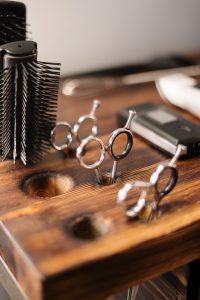Are You Ready to Master the Art of Home Hair Trimming?

With some patience and careful technique, it is absolutely possible to cut your own hair at home—even if you have bangs or layers! Reaching out to your stylist for a FaceTime/Zoom appointment can be incredibly beneficial. Not only do they know the intricacies of your hair better than anyone else, but they will also guide you through each step.
Don’t worry—taking on this task yourself isn’t crazy; with a little research and practice, it just might become one of those “pinch me” situations where you won’t believe how much money (and time) you saved!
If you’re considering shearing your fringe, chopping layers into your locks, or snipping off split ends, then read through these tips first. These strategies apply to all lengths and textures of hair; so go ahead and give them a try! Even if you can’t book an appointment with a stylist virtually, feel free to take matters into your own hands.
1. Invest in a Good Pair of Scissors
If you have some time to spare, invest in the best quality scissors available. Arc scissors are terrific and widely used by stylists, though they can be pricey. Kamisori is another top-notch brand that may suit your needs better.
Whatever choice you make, do ensure that the blades of your scissors are sharp before use; while this will not guarantee ideal results, it’s much safer than using dull blades at a faster pace!
2. Wet Hair
For a better view of your styling progress, wet hair is the way to go! For optimal results, start with either towel-dried wet hair or water-spritzed dry hair. Then you’ll be ready to go!
3. Ponytail
When your hair isn’t long enough for a ponytail, employ an elastic band to quickly gather all of it.
4. Select the Specific Layers
Use either a brush, comb or simply your fingers to shape them and smooth the hairs against your skin.
5. Figure Out the Area of Your Hair You Want to Trim
When your hair is wet, it tends to stretch out. Therefore, keep in mind that less is more when cutting. With any type of haircutting or styling, take time to do a bit and then step back for a better look at what you have done before making additional adjustments. Go cautiously as you work with your scissors!
6. Begin Stunning Quarter-Inch Trim
When it comes to haircutting, sectioning is key. For sections around the face, they should be smaller so that if a mistake happens, there’s still more room for control and correction.
Many people think of chopping everything off in one straight line when doing a blunt cut, but what you really want to do is take advantage of the less severe “point cut” or twist-and-cut methods; these will save you time and energy even when dealing with blunt cuts!
7. Point Cut
Firmly grasp the section of hair with your fingers and align them horizontally, using this as a guide for how much you will cut. Begin making small upward cuts until all strands in the section are trimmed, then repeat on other sections. You can work randomly or strategically—it’s up to you!
8. To Turn and Trim
For those of us who are timid (like myself!), here’s a less professional approach that still works wonders. Take your section, twist it with your fingers, and cut—this is the key to achieving an ultimately natural-looking finish! Twisting helps position each piece at different angles and lengths for added texture, which prevents any blunt or obvious edges from appearing. Even though I can’t quite explain how effective this method really is in words, trust me when I say: it works!
9. Give Yourself Layers
For optimal vision and convenience, gently fan your sectioned hair across your face. If you don’t have enough length for this step, no problem—the goal is to simply help you see better! Once that’s taken care of, move up a one-quarter inch and either twist or point-cut. Repeat until complete. This method may challenge your patience slightly; however, it will be worth the effort in the end!
10. Focus on the Ends
To begin, part your hair down the center of your head and gently pull each section forward. Cut as you would like, whether through point-cutting, twisting, or cutting straight across. Step back occasionally to check that it’s even on both sides. The best scenario is having someone else cut it for you; nevertheless, if that’s not possible, be sure to assess how it looks after pulling the sections apart at the nape of your neck before finalizing with a trim! You can do this yourself just fine!

